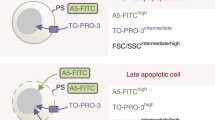Abstract
Several reports indicate that the cytosol is acidified during apoptosis although the mechanism is not yet fully elucidated. The most acidic organelle found in the cell is the lysosome, raising the possibility that lysosomal proton release may contribute to the cytosolic acidification. We here describe methods for measurement of the cytosolic and lysosomal pH in U937 cells by a dual-emission ratiometric technique suitable for flow cytometry. Cytosolic pH was analysed in cells loaded with the fluorescent probe BCECF, while lysosomal pH was determined after endocytosis of FITC-dextran. Standard curves were obtained by incubating cells in buffers with different pH in the presence of the proton ionophore nigericin. Apoptosis was induced by exposure of cells to 10 ng/ml TNF-α for 4 h, and apoptotic cells were identified using a fluorescent marker for active caspases. By gating of control and apoptotic cells, the cytosolic and lysosomal pH were calculated in each population. The cytosolic pH was found to decrease from 7.2 ± 0.1 to 5.8 s± 0.1 and the lysosomal increased from 4.3 ± 0.4 to 5.2 ± 0.3. These methods will be useful in future attempts to evaluate the involvement of lysosomes in the acidification of the cytosol during apoptosis.
Similar content being viewed by others
References
Afford S, Randhawa S (2000). Apoptosis. Mol Pathol 53:55–63.
Geisow MJ (1984). Fluorescein conjugates as indicators of subcellular pH. A critical evaluation. Exp Cell Res 150:29–35.
Gottlieb RA, Nordberg J, Skowronski E, Babior BM (1996). Apoptosis induced in Jurkat cells by several agents is preceded by intracellular acidification. Proc Natl Acad Sci USA 93:654–658.
Li J, Eastman A (1995). Apoptosis in an interleukin-2-dependent cytotoxic T lymphocyte cell line is associated with intracellular acidification. Role of the Na+/H+-antiport. J Biol Chem 270: 3203–3211
Liu D, Martino G, Thangaraju M, Sharma M, Halwani F, Shen SH, Patel YC, Srikant CB (2000). Caspase-8-mediated intracellular acidification precedes mitochondrial dysfunction in somatostatin-induced apoptosis. J Biol Chem 275:9244–9250.
Matsuyama S, Llopis J, Deveraux QL, Tsien RY, Reed JC (2000). Changes in intramitochondrial and cytosolic pH: early events that modulate caspase activation during apoptosis. Nat Cell Biol 2:318–325.
Xie Z, Schendel S, Matsuyama S, Reed JC (1998). Acidic pH promotes dimerization of Bcl-2 family proteins. Biochemistry 37:6410–6418.
de Duve C. Lysosomes. (1959). A new group of cytoplasmic particles. In: de Duve C (ed) Subcellular Particles; p. 128–159.
Hirpara JL, Clement MV, Pervaiz S (2001). Intra-cellular acidification triggered by mitochondrial-de-rived hydrogen peroxide is an effector mechanism for drug-induced apoptosis in tumor cells. J BiolChem 276:514–521.
Perez-Sala D, Collado-Escobar D, Mollinedo F (1995). Intracellular alkalinization suppresses lova-statin-induced apoptosis in HL-60 cells through the inactivation of a pH-dependent endonuclease. J Biol Chem 270:6235–6242
Matsuyama S, Reed JC(2000) Mitochondria-dependent apoptosis and cellular pH regulation. Cell Death Differ 7:1155–1165.
Matsuyama S, Schendel SL, Xie Z, Reed JC (1998). Cytoprotection by Bcl-2 requires the pore-forming alpha5 and alpha6 helices. J Biol Chem 273:30995–31001.
Schendel SL, Azimov R, Pawlowski K, Godzik A, Kagan BL, Reed JC (1999). Ion channel activity of the BH3 only Bcl-2 family member, BID. J Biol Chem 274:21932–21936.
Schendel SL, Xie Z, Montal MO, Matsuyama S, Montal M, Reed JC (1997). Channel formation by antiapoptotic protein Bcl-2. Proc Natl Acad Sci USA 94:5113–5118.
Schlesinger PH, Gross A, Yin XM, Yamamoto K, Saito M, Waksman G, Korsmeyer SJ (1997). Com-parison of the ion channel characteristics of proa-poptotic BAX and antiapoptotic BCL-2. Proc Natl Acad Sci USA 94:11357–11362.
Kågedal K, Zhao M, Svensson I, Brunk UT (2001). Sphingosine-induced apoptosis is dependent on lysosomal proteases. Biochem J 359:335–343.
Brunk UT, Zhang H, Dalen H, Öllinger K (1995). Exposure of cells to nonlethal concentrations of hydrogen peroxide induces degeneration-repair mechanisms involving lysosomal destabilization. Free Radic Biol Med 19:813–822.
Davies TA, Fine RE, Johnson RJ, Levesque CA, Rathbun WH, Seetoo KF, Smith SJ, Strohmeier G, Volicer L, Delva L (1993). Non-age related differ-ences in thrombin responses by platelets from male patients with advanced Alzheimer’s disease. Bio-chem Biophys Res Commun 194:537–543.
Martin GR, Jain RK (1994). Noninvasive mea-surement of interstitial pH profiles in normal and neoplastic tissue using fluorescence ratio imaging microscopy. Cancer Res 54:5670–5674.
Bach G, Chen CS, Pagano RE (1999). Elevated lysosomal pH in Mucolipidosis type IV cells. Clin Chim Acta 280:173–179.
Myers BM, Tietz PS, Tarara JE, LaRusso NF (1995). Dynamic measurements of the acute and chronic effects of lysosomotropic agents on hepa-tocyte lysosomal pH using flow cytometry. Hepa-tology 22:1519–1526.
Ohkuma S, Poole B (1978). Fluorescence probe measurement of the intralysosomal pH in living cells and the perturbation of pH by various agents. Proc Natl Acad Sci USA 75: 3327–3331.
Furlong IJ, Ascaso R, Lopez Rivas A, Collins MK (1997). Intracellular acidification induces apoptosis by stimulating ICE-like protease activity. J Cell Sci 110:653–661.
Reynolds JE, Li J, Eastman A (1996). Detection of apoptosis by flow cytometry of cells simultaneously stained for intracellular pH (carboxy SNARF-1) and membrane permeability (Hoechst 33342). Cytometry 25:349–357.
Reijngoud D, Tager JM (1975). Effect of ionophores and temperature on intralysosomal pH. FEBS Lett 54:76–79.
Ishaque A, Al-Rubeai M (1998). Use of intracellular pH and annexin-V flow cytometric assays to moni-tor apoptosis and its suppression by bcl-2 over-expression in hybridoma cell culture. J Immunol Methods 221:43–57.
Thangaraju M, Sharma K, Leber B, Andrews DW, Shen SH, Srikant CB (1999). Regulation of acidification and apoptosis by SHP-1 and Bcl-2. J Biol Chem 274:29549–29557.
Author information
Authors and Affiliations
Corresponding author
Rights and permissions
About this article
Cite this article
Nilsson, C., Kågedal, K., Johansson, U. et al. Analysis of cytosolic and lysosomal pH in apoptotic cells by flow cytometry. Methods Cell Sci 25, 185–194 (2004). https://doi.org/10.1007/s11022-004-8228-3
Revised:
Issue Date:
DOI: https://doi.org/10.1007/s11022-004-8228-3




